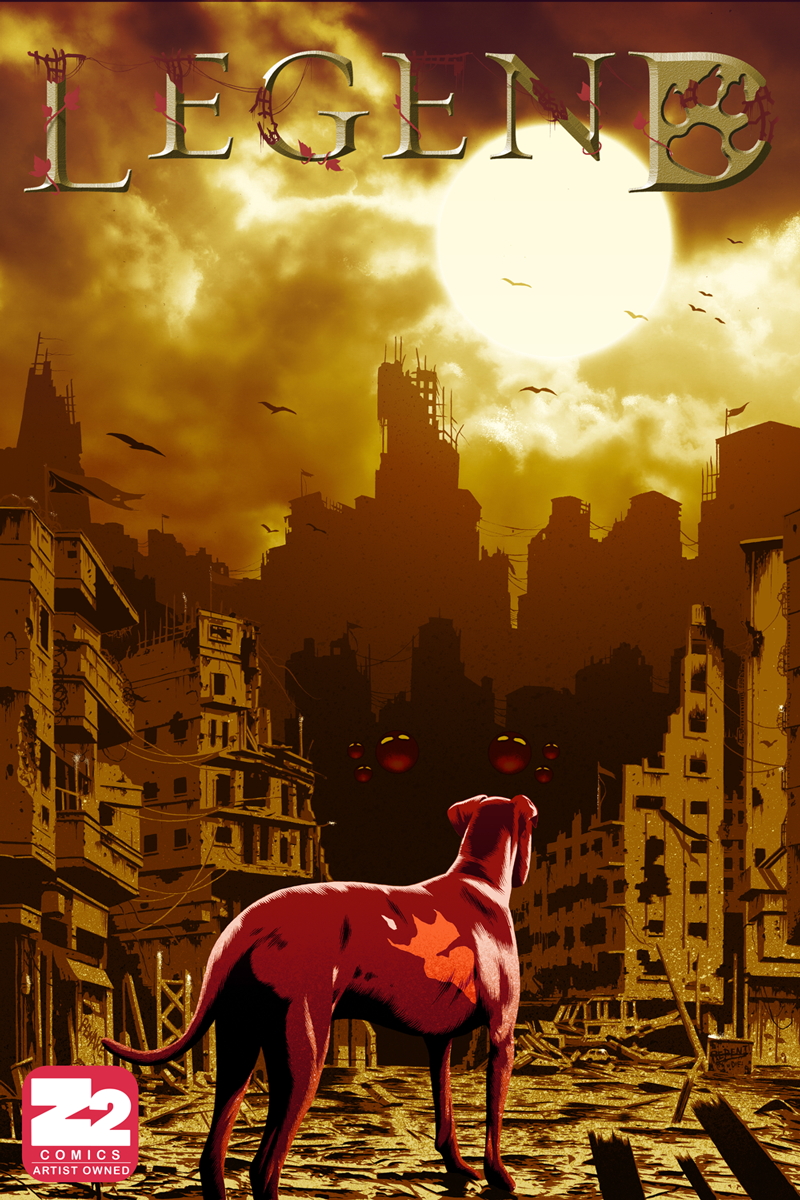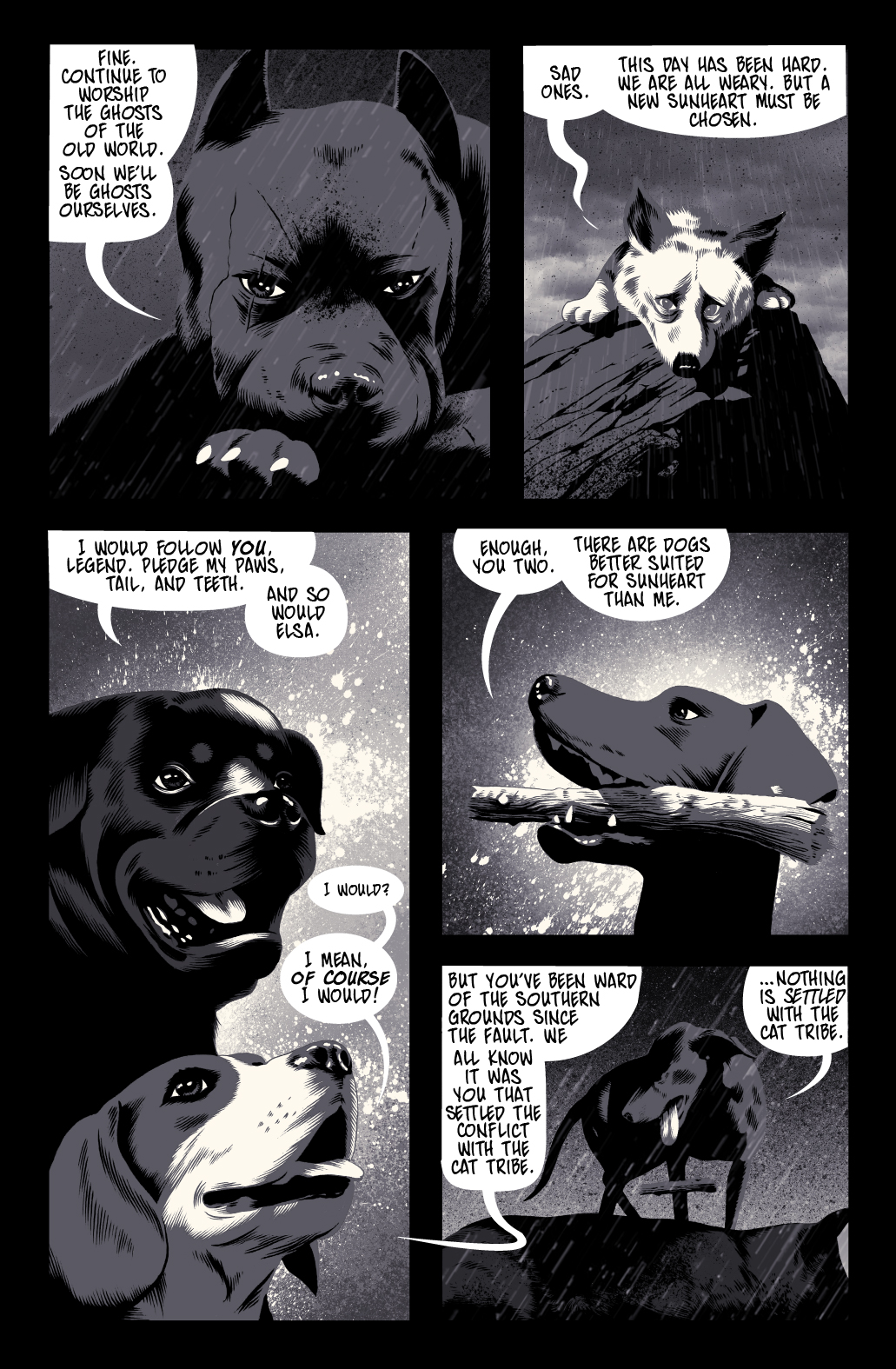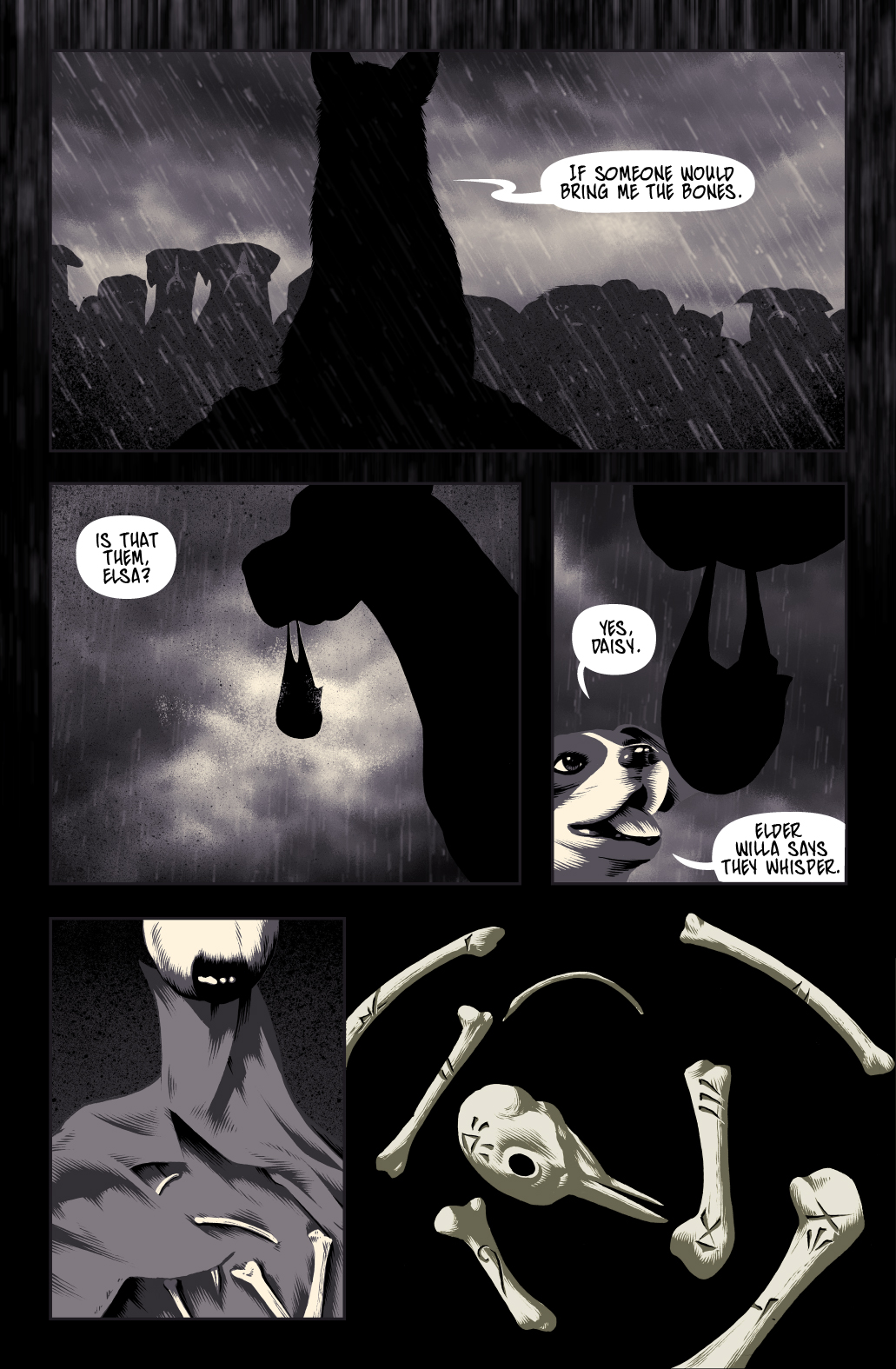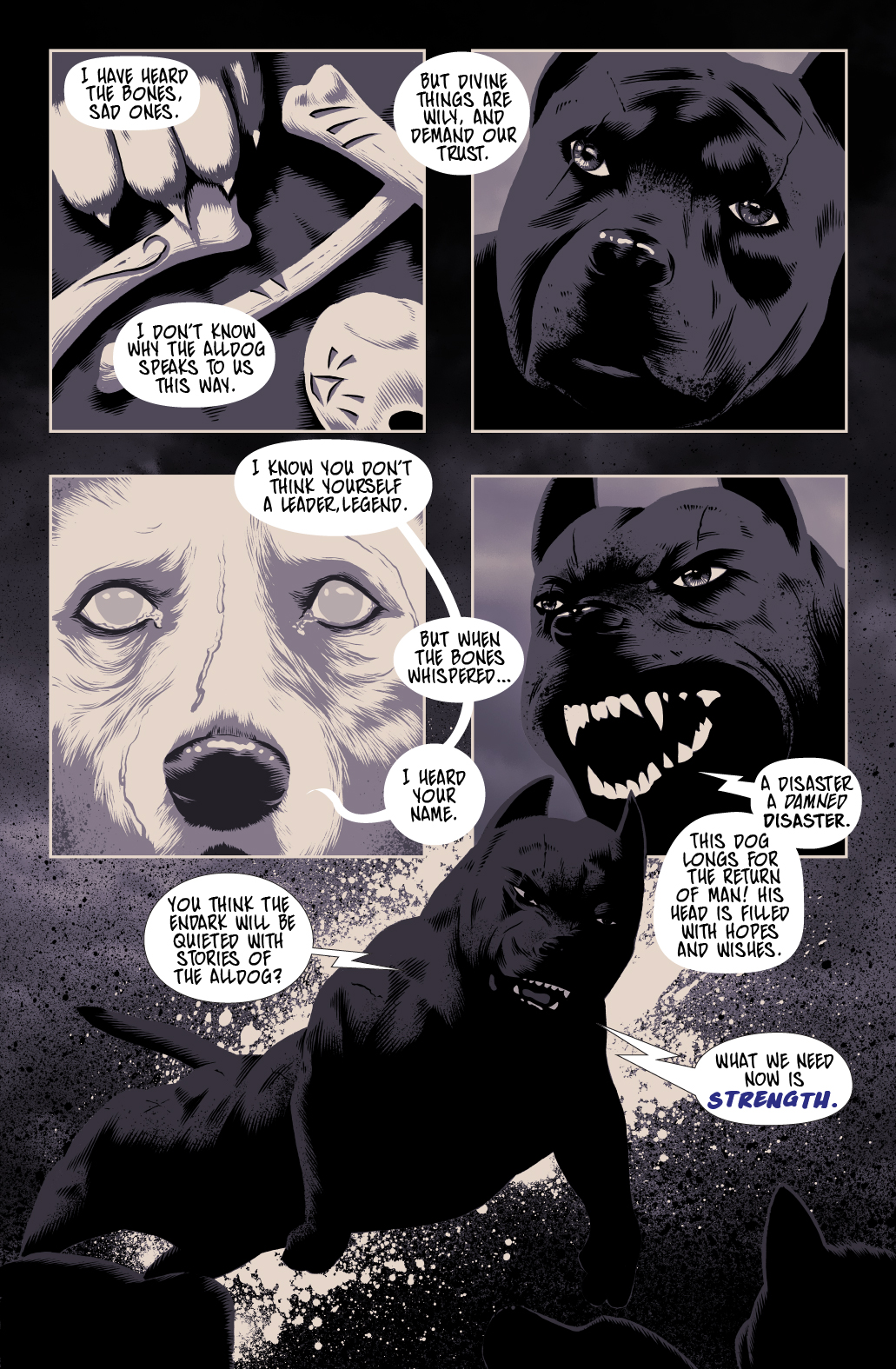Warren Ellis has often written books with an air of excess. The charm of Spider-Jerusalem lay in his seemingly bottomless well of vulgarities while the wonder of Planetary lived in its free-for-all approach to adding disturbing twists to every kind of fictional world. It may seem a little odd then, that I find issue eight of Injection faltering mainly when Ellis allows the book to be as crazy and crass as his past masterworks. The problem is that Injection has been defined by a surprising sense of discipline up until now. The book deals with weird science and magic with an approach that has consistently been subtler and more stayed than anything Ellis has done since Fell. But this second arc in places feels like a different, less intelligent book, especially when focusing on the well-travelled Vivek Headland and his pulpy adventures.
Issue eight follows Vivek's continuing investigations of his ghost-sex case which remains hugely amusing, if at times a little disturbing. Meanwhile Brigid and Simeon continue to banter like siblings as they prepare to leave for New York. Their brief scene is a light but telling sequence that does a lot to flesh the characters out. Beyond the pop-culture references (Simeon thinks Idris Elba, whom Declan Shalvey modeled him on, should play James Bond), it's nice to see two character who care about each other in a way that is warm and believable (as a counterpoint to Vivek's constant strangeness). And of course, Shalvey's uncanny ability to light scenes via glowing scientific orbs doesn't hurt.
 After the Brig and Sim scene, the problems set in as the issue detours to a steadily more ridiculous tour of Headland's sexual history which ranges from the creepy (he apparently had sex in grade school with his much older teacher) to the, well, weird and creepy ('dongzilla' the sex toy). I will admit I am not often a fan of graphic sex in comics. As with graphic violence, the use of explicit sex more often than not is a journey into gratuitousness for its own sake without adding anything much to the story. But even with my personal tastes aside, the central section of this issue feels like a different comic entirely. While it is in keeping with what we know of Headland that he would have a bizarre sexual past, I don't think the sequence added anything to my understanding of him as a character. And more unforgivably, Ellis establishes four of the central characters as sexual partners. While there is a separate discussion to be had about the sexual politics of the scene (apparently most members of the cursus are bisexual), it doesn't fit with anything we know about the characters or their relationships to each other.
After the Brig and Sim scene, the problems set in as the issue detours to a steadily more ridiculous tour of Headland's sexual history which ranges from the creepy (he apparently had sex in grade school with his much older teacher) to the, well, weird and creepy ('dongzilla' the sex toy). I will admit I am not often a fan of graphic sex in comics. As with graphic violence, the use of explicit sex more often than not is a journey into gratuitousness for its own sake without adding anything much to the story. But even with my personal tastes aside, the central section of this issue feels like a different comic entirely. While it is in keeping with what we know of Headland that he would have a bizarre sexual past, I don't think the sequence added anything to my understanding of him as a character. And more unforgivably, Ellis establishes four of the central characters as sexual partners. While there is a separate discussion to be had about the sexual politics of the scene (apparently most members of the cursus are bisexual), it doesn't fit with anything we know about the characters or their relationships to each other.
But exactly when the book was at its weakest (a double bedmate reveal that reads like a very odd rom-com scene), Robin Morel comes to the rescue. In a cast with so much diversity, I feel a little guilty that I like the white male lead the best (Maria complains about just this sort of behavior), but Robin is a fascinating, fully-realized character in a way the others simply aren't yet. Ellis has experience writing a more famous run-down British magician, but Robin Morel is a far more humane, moral man than John Constantine. As the cursus members engage in 'human interaction', Robin confronts literal ghosts from his past, and, later, confronts the series big bad in what is the better of the issue's two cliffhangers. His subplot is so strong that despite it's entirely different tone from the main plot, it made the issue most palatable.
All told, I am more than a little disappointed in Injection #8. The long sequence of sexual excess will likely not bother Ellis' many diehard fans, but for me, it strikes a discordant note in a series that has been sharply unified in its tone. With the format of 'Injection' being one arc for each character, I find myself increasingly hoping that when the focus shifts from Vivek Headland, the series will get back to the grounded, haunting material it began from. While I can only hope the next arc focuses on Robin Morel, I would settle for anything that meant a little less jokey flashbacks, and a little more Declan Shalvey fantasy-scapes.
Score: 4/5
Injection #8
Writer: Warren Ellis
Artist: Declan Shalvey
Publisher: Image Comics
Price: $3.99
Release Date: 3/16/16
Format: Ongoing; Print/Digital






 The other side of the territory is revealed, this issue hits straight into it as the Warlord for the Arcanics She presents herself in front of the Queen of Wolves, and the revelation of the cease fire between them and the Cumaea. Meanwhile in the woods, a tiny Fox who follows Maika, make an attempt to settle for the night, as the horrible creature inside here wakes up and tries to feed on anything close. The monster inside Maika is fully awake, it wants out and it’s hungry…
The other side of the territory is revealed, this issue hits straight into it as the Warlord for the Arcanics She presents herself in front of the Queen of Wolves, and the revelation of the cease fire between them and the Cumaea. Meanwhile in the woods, a tiny Fox who follows Maika, make an attempt to settle for the night, as the horrible creature inside here wakes up and tries to feed on anything close. The monster inside Maika is fully awake, it wants out and it’s hungry… Wynonna is a fun character to read. Unfortunately the supporting characters such as her superior Agent Dolls, appear to be more plot functions than fleshed out characters. This was a problem I had in the first issue. An improvement was made with the introduction of the character of John Henry, who serves as an ally to Wynonna during her mission. He has enough of the mouthy sarcastic persona that he is able to have entertaining banter with her. Mars Del Rey was a big bad mentioned in the last issue that did not appear. The build up from last issue was that he would be a major villain. That didn’t come across in the way he was drawn and portrayed in this issue. From the moment he’s introduced he looks like a normal dude and doesn’t stand out as someone to be feared. Without giving too much away the confrontation between him and Wynonna was the least action-packed point in the story.
Wynonna is a fun character to read. Unfortunately the supporting characters such as her superior Agent Dolls, appear to be more plot functions than fleshed out characters. This was a problem I had in the first issue. An improvement was made with the introduction of the character of John Henry, who serves as an ally to Wynonna during her mission. He has enough of the mouthy sarcastic persona that he is able to have entertaining banter with her. Mars Del Rey was a big bad mentioned in the last issue that did not appear. The build up from last issue was that he would be a major villain. That didn’t come across in the way he was drawn and portrayed in this issue. From the moment he’s introduced he looks like a normal dude and doesn’t stand out as someone to be feared. Without giving too much away the confrontation between him and Wynonna was the least action-packed point in the story. The issue begins in New York, 1953 as Armstrong and one of his many friends raiding a restaurant that serves as a mafia front. As per usual with the immortal drunk, everything goes wrong and they have to bust their way out and enjoy some of the great booze Armstrong was able to put in his bag. Jump into present day with the big man holding an obituary cut-out of his friend who’s died at the age of 89. Something seems to have happened between them, but still deserves a toast of that very expensive alcohol, there is one problem. The booze is nowhere to be found. Archer comes later that day to find a empty room, and an open infinity bag on the floor. Armstrong has gone in and all manner of creatures are coming out.
The issue begins in New York, 1953 as Armstrong and one of his many friends raiding a restaurant that serves as a mafia front. As per usual with the immortal drunk, everything goes wrong and they have to bust their way out and enjoy some of the great booze Armstrong was able to put in his bag. Jump into present day with the big man holding an obituary cut-out of his friend who’s died at the age of 89. Something seems to have happened between them, but still deserves a toast of that very expensive alcohol, there is one problem. The booze is nowhere to be found. Archer comes later that day to find a empty room, and an open infinity bag on the floor. Armstrong has gone in and all manner of creatures are coming out.



 So... why don't the Ghostbusters cross the streams now? After the danger has grown beyond their ability to manage, what's stopping them? Did they just never think to do it in this splinter universe? Are they too afraid of the consequences? It always struck me as a needless risk in the movie. And I think there could be a decent conversation on the subject. Deviations addresses this. But only in passing. This comic is only interested in a handful of jokes facilitated by the alternate universe.
So... why don't the Ghostbusters cross the streams now? After the danger has grown beyond their ability to manage, what's stopping them? Did they just never think to do it in this splinter universe? Are they too afraid of the consequences? It always struck me as a needless risk in the movie. And I think there could be a decent conversation on the subject. Deviations addresses this. But only in passing. This comic is only interested in a handful of jokes facilitated by the alternate universe. Though the radiation on the surface is enough to kill humans without protection from pills or suits it appears that the thousands of years of radiated living have caused different life to emerge. Giant humanoid rats are returning home from their hunting trip, and we catch a glimpse of their civilization before hell breaks loose. Stel gazes down from their cliff side hiding spot at baby rat people hugging their fathers for bringing back such a bounty when from the sky dozens of bee soldiers called “The Swarm” begin to attack. It’s a massacre, and leaves the rats decimated as the bees fly off with rat corpses for their Queen. The entire scene felt out-of-place, and took me off guard. Maybe this was out-of-place for the human-run underwater worlds of
Though the radiation on the surface is enough to kill humans without protection from pills or suits it appears that the thousands of years of radiated living have caused different life to emerge. Giant humanoid rats are returning home from their hunting trip, and we catch a glimpse of their civilization before hell breaks loose. Stel gazes down from their cliff side hiding spot at baby rat people hugging their fathers for bringing back such a bounty when from the sky dozens of bee soldiers called “The Swarm” begin to attack. It’s a massacre, and leaves the rats decimated as the bees fly off with rat corpses for their Queen. The entire scene felt out-of-place, and took me off guard. Maybe this was out-of-place for the human-run underwater worlds of  The comic medium allows for grand sights and effects unattainable in the show's era. However, IALiS:TLA (it‘s even worse as an acronym) doesn't take advantage of the strengths provided by comics. Vistas are vast, but empty. Technology is vague and cheap looking. In trying to mimic the look of the show, the comic limits its visual scope to an unfortunate degree. I wish the art could be bigger, more awe-inspiring. The set and prop designers on the show had images in their heads that were almost certainly not reflected in the final, produced episodes. Here’s a chance to go crazy and unshackle the look from the constraints of reality.
The comic medium allows for grand sights and effects unattainable in the show's era. However, IALiS:TLA (it‘s even worse as an acronym) doesn't take advantage of the strengths provided by comics. Vistas are vast, but empty. Technology is vague and cheap looking. In trying to mimic the look of the show, the comic limits its visual scope to an unfortunate degree. I wish the art could be bigger, more awe-inspiring. The set and prop designers on the show had images in their heads that were almost certainly not reflected in the final, produced episodes. Here’s a chance to go crazy and unshackle the look from the constraints of reality. Devolution
Devolution When I first saw the cover for Jetty I had no idea what to expect. I mean… that’s a crazy ass cover and really that’s exactly what you should expect from Jetty… craziness. The first issue explains the story so far… which is weird because I just wrote “first issue.” We’re given a breakdown of characters and a little of their backstory and it’s goofy, but fun sounding.
Then we’re thrown into the book… and I mean that. We’re thrown into the middle of a conflict that’s happening one billion minutes in the future as Sea Bandits with helicopter hats are attacking Buddhist monks. It’s a brutal scene, but also kind of funny as Monk’s attempt to defend themselves and really suck at it. They load up the Beach Beetle (which is a character in the story) with the injured and there just so happens to be belts to strap down everyone and they get the hell out of there.
When I first saw the cover for Jetty I had no idea what to expect. I mean… that’s a crazy ass cover and really that’s exactly what you should expect from Jetty… craziness. The first issue explains the story so far… which is weird because I just wrote “first issue.” We’re given a breakdown of characters and a little of their backstory and it’s goofy, but fun sounding.
Then we’re thrown into the book… and I mean that. We’re thrown into the middle of a conflict that’s happening one billion minutes in the future as Sea Bandits with helicopter hats are attacking Buddhist monks. It’s a brutal scene, but also kind of funny as Monk’s attempt to defend themselves and really suck at it. They load up the Beach Beetle (which is a character in the story) with the injured and there just so happens to be belts to strap down everyone and they get the hell out of there. Jetty is fun. It’s entertaining and while the narrative walks to the beat of its own drum, it’s not bad. It’s experimental in parts and for the most part I think that it’s successful in its experiment. The narrative may not be deep at the moment, but it’s easy to follow even if it feels disjointed at times. The characters are goofy and interesting making the story a romp to follow.
Jetty is fun. It’s entertaining and while the narrative walks to the beat of its own drum, it’s not bad. It’s experimental in parts and for the most part I think that it’s successful in its experiment. The narrative may not be deep at the moment, but it’s easy to follow even if it feels disjointed at times. The characters are goofy and interesting making the story a romp to follow. ‘Hannah’s Reflection’ is the name I have given to what may be Tessa Fowler’s greatest artistic contribution to the series. I mean EVER. Near the end of the issue there is this incredibly honest moment where Hannah is walking from room to room, shedding her clothes as she goes; almost as if she is peeling off layers of herself with each falling article. She comes to a stop in front a full body mirror, surveying her naked body as if for the first time and she is absolutely beautiful. Her hair is let down to expose her horns and the effect is nothing short of sinister (yet so seductive that Adam would have ate an orchard). She’s smiling but she’s not happy, her eyes are foccussed but not kind. This is the moment where Hannah becomes reborn in the flames. Where she embraces her darkness and willingly sets upon her path of self-destruction. It's a perfect juxtaposition and a stunning portrayal of the paradoxes of beauty.
‘Hannah’s Reflection’ is the name I have given to what may be Tessa Fowler’s greatest artistic contribution to the series. I mean EVER. Near the end of the issue there is this incredibly honest moment where Hannah is walking from room to room, shedding her clothes as she goes; almost as if she is peeling off layers of herself with each falling article. She comes to a stop in front a full body mirror, surveying her naked body as if for the first time and she is absolutely beautiful. Her hair is let down to expose her horns and the effect is nothing short of sinister (yet so seductive that Adam would have ate an orchard). She’s smiling but she’s not happy, her eyes are foccussed but not kind. This is the moment where Hannah becomes reborn in the flames. Where she embraces her darkness and willingly sets upon her path of self-destruction. It's a perfect juxtaposition and a stunning portrayal of the paradoxes of beauty. The next two being one about a billionaire that has an Iron Man suit, minus the helmet… which seems like an oversight. He did hilariously get bumped into by a random person and make a note to himself to fire the guy. There was no context really for this so it was just dumb fun. I don’t even know if the guy actually works for him or not since I think he was in a public place, but whatever.
The next two being one about a billionaire that has an Iron Man suit, minus the helmet… which seems like an oversight. He did hilariously get bumped into by a random person and make a note to himself to fire the guy. There was no context really for this so it was just dumb fun. I don’t even know if the guy actually works for him or not since I think he was in a public place, but whatever.

 There is some character development, but really Luther is maxed out. The only way he can develop more is if he can convince Cain or beat Cain. That’s his journey now. Otherwise he and Petra are fully developed characters and they’re just riding out the end of the series in the best possible way, completely exposed to the reader. If you’ve followed the series, then you know them quite well and that’s what makes this volume pretty damn satisfying.
There is some character development, but really Luther is maxed out. The only way he can develop more is if he can convince Cain or beat Cain. That’s his journey now. Otherwise he and Petra are fully developed characters and they’re just riding out the end of the series in the best possible way, completely exposed to the reader. If you’ve followed the series, then you know them quite well and that’s what makes this volume pretty damn satisfying.
 The only problem I see with this issue is that it’s a little like getting an appetizer that you didn’t order. Sure you’ll eat it because you’re hungry, but it makes you wonder what’s going on with your food that they had to give you an appetizer? I say this because the way the fourth issue ended really captured your attention. I mean it was a huge shake up after seeing the hell Gilad goes through to leave his paradise every time. To not get that this time… well, it’s like that appetizer you didn’t order. It’s a good issue, but I was expecting my meal to come out and instead I’m left waiting longer. Still, I can’t deny that I enjoyed the issue.
The only problem I see with this issue is that it’s a little like getting an appetizer that you didn’t order. Sure you’ll eat it because you’re hungry, but it makes you wonder what’s going on with your food that they had to give you an appetizer? I say this because the way the fourth issue ended really captured your attention. I mean it was a huge shake up after seeing the hell Gilad goes through to leave his paradise every time. To not get that this time… well, it’s like that appetizer you didn’t order. It’s a good issue, but I was expecting my meal to come out and instead I’m left waiting longer. Still, I can’t deny that I enjoyed the issue. After the Brig and Sim scene, the problems set in as the issue detours to a steadily more ridiculous tour of Headland's sexual history which ranges from the creepy (he apparently had sex in grade school with his much older teacher) to the, well, weird and creepy ('dongzilla' the sex toy). I will admit I am not often a fan of graphic sex in comics. As with graphic violence, the use of explicit sex more often than not is a journey into gratuitousness for its own sake without adding anything much to the story. But even with my personal tastes aside, the central section of this issue feels like a different comic entirely. While it is in keeping with what we know of Headland that he would have a bizarre sexual past, I don't think the sequence added anything to my understanding of him as a character. And more unforgivably, Ellis establishes four of the central characters as sexual partners. While there is a separate discussion to be had about the sexual politics of the scene (apparently most members of the cursus are bisexual), it doesn't fit with anything we know about the characters or their relationships to each other.
After the Brig and Sim scene, the problems set in as the issue detours to a steadily more ridiculous tour of Headland's sexual history which ranges from the creepy (he apparently had sex in grade school with his much older teacher) to the, well, weird and creepy ('dongzilla' the sex toy). I will admit I am not often a fan of graphic sex in comics. As with graphic violence, the use of explicit sex more often than not is a journey into gratuitousness for its own sake without adding anything much to the story. But even with my personal tastes aside, the central section of this issue feels like a different comic entirely. While it is in keeping with what we know of Headland that he would have a bizarre sexual past, I don't think the sequence added anything to my understanding of him as a character. And more unforgivably, Ellis establishes four of the central characters as sexual partners. While there is a separate discussion to be had about the sexual politics of the scene (apparently most members of the cursus are bisexual), it doesn't fit with anything we know about the characters or their relationships to each other. The writing is sharp on this issue. I don’t know how many more there are in the series, but I like the reveals of this issue. It gives us a lot of insight, but then it also manages to leave us plenty to discover on the ending. I personally find mini-series that over expose the second to last issue to be poorly plotted because the only reason you have to read the final issue is to see if they really deliver the ending you’ve already figured out. With Project Nemesis I’m very curious to see how they’ll use the information they have rather than just see them take down the monster. Right now I have an idea of their options, but I really need to see how they’ll go about everything which makes for a rewarding conclusion already.
The writing is sharp on this issue. I don’t know how many more there are in the series, but I like the reveals of this issue. It gives us a lot of insight, but then it also manages to leave us plenty to discover on the ending. I personally find mini-series that over expose the second to last issue to be poorly plotted because the only reason you have to read the final issue is to see if they really deliver the ending you’ve already figured out. With Project Nemesis I’m very curious to see how they’ll use the information they have rather than just see them take down the monster. Right now I have an idea of their options, but I really need to see how they’ll go about everything which makes for a rewarding conclusion already. I was disappointed that the resolution came so quickly and easily. Even though it’s an issue zero I felt there was more potential to add more to the main plot. The other main characters are the highlight of this book. Their conflicting personalities remind me a lot of a police comedy sitcom like Brooklyn Nine-Nine. If the series continues there’s a lot of potential for these characters. This issue is more about the operations of the group as a whole which makes the title a little misleading. I also don’t think Cthulhu deserves it. He’s that boring.
I was disappointed that the resolution came so quickly and easily. Even though it’s an issue zero I felt there was more potential to add more to the main plot. The other main characters are the highlight of this book. Their conflicting personalities remind me a lot of a police comedy sitcom like Brooklyn Nine-Nine. If the series continues there’s a lot of potential for these characters. This issue is more about the operations of the group as a whole which makes the title a little misleading. I also don’t think Cthulhu deserves it. He’s that boring.